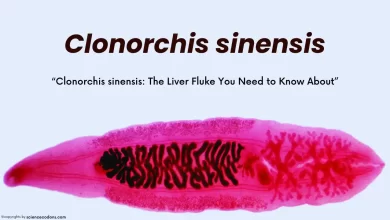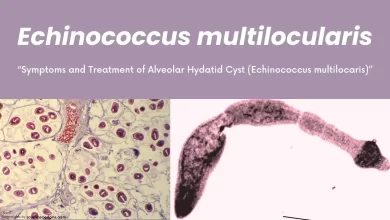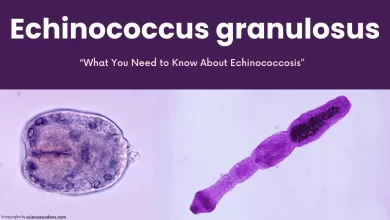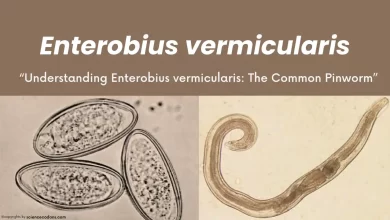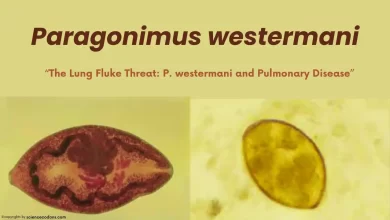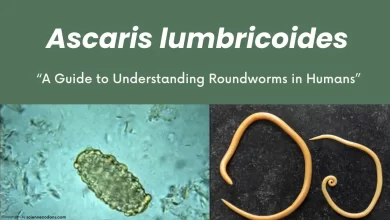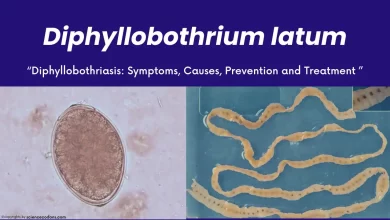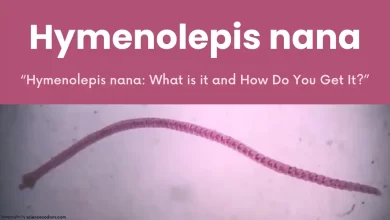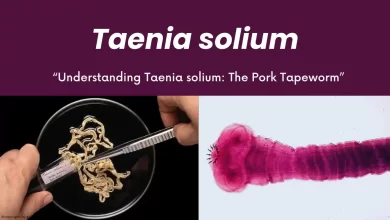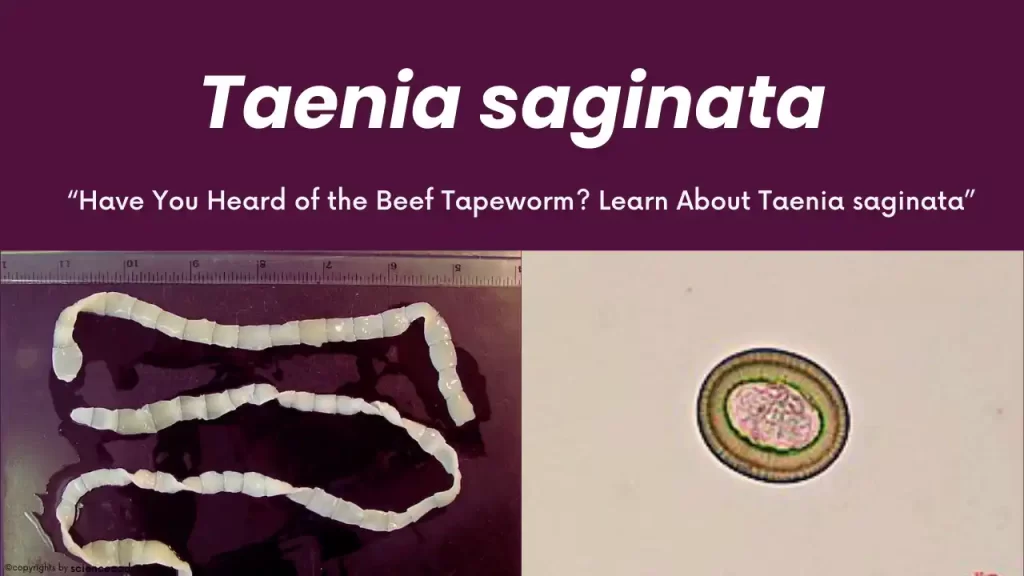
Taenia saginata, also known as the beef tapeworm, is a type of worm from the cestodes group that belongs to the Cyclophyllidae order and the Taeniidae family. It is commonly referred to as the bovine tapeworm. This name originates from the fact that humans can become infected by consuming raw or undercooked beef. After H.nana, it is the most prevalent cestode in humans. This worm can live in the human small intestine for up to 30 years.
What is Taenia saginata? [Morphology & Characteristics]
It is the most common member of the Taeniidae family that causes diseases in humans. Morphologically, these worms are white or milky in color. They can reach lengths of 4-12 meters and sometimes up to 25 meters. Adult worms have 1000-2000 proglottids or segments. The worm’s scolex[or head] is spherical and unarmed, meaning it lacks a rostellum and hooks. There are four suckers on the scolex. This worm is often called the “pumpkin worm” because the mature proglottids resemble pumpkin seeds.
Epidemiology of taeniasis(T. saginata)
Epidemiologically, Taenia saginata infection is globally prevalent. It is widespread in countries like India, Italy, and France, where meat is often consumed as steak or half-cooked. The Infection is transmitted through the larval stage of Cysticercus bovis, located in the meat muscles. If the meat is frozen at -18 degrees for 15 days or cooked for a few minutes at 75 degrees, the larvae are eliminated. In Iran, Mazandaran and Gilan provinces have the highest infection rates at 17% and 14%, respectively.
The life cycle of Taenia saginata
The life cycle of T. saginata involves two hosts:
- The primary host is humans, where the adult worm lives in the intestine.
- The intermediate host is cattle, where the larva or juvenile form, known as Cysticercus bovis, lives in the muscles.
The adult worm in the human body releases proglottids that contain eggs. These proglottids are excreted with feces and can contaminate water and sewage. Eventually, these eggs end up on fodder, which cattle can consume and become infected. The egg walls are removed, and the six-hooked embryo, or oncosphere, is released and travels to the striated muscles of the cow via the bloodstream. There, it develops into a sac and a head, known as Cysticercus bovis. This stage takes about 2 months.
If a human consumes these infected muscles raw or half-cooked, the meat is digested in the digestive system, and Cysticercus bovis, which was invaginated or sunk (the head was sunk in the sac), comes out as evaginated (the head is out of the sac). The sac is excreted, and the Taenia saginata worm attaches to the villi of the intestine using its suckers. It matures in 8-10 weeks and begins releasing proglottids and feces.
| Stage | Description |
|---|---|
| Egg or Gravid Proglottid Release | Passed with feces, can survive for days to months in the environment. |
| Ingestion by Intermediate Host (Cattle) | Eggs are ingested by cattle when grazing; oncospheres hatch in the intestine. |
| Oncosphere Migration | Oncospheres penetrate intestinal wall, migrate to striated muscles, develop into cysticerci. |
| Ingestion by Definitive Host (Humans) | Humans ingest raw or undercooked infected meat. |
| Development into Adult Tapeworm | In human intestine, cysticercus develops into adult tapeworm over 2 months. |
| Proglottid Maturation and Release | Adult tapeworms produce proglottids that mature, detach, and are passed in stool. |
Symptoms of Taenia saginata Infection
Most T. saginata infections(taeniasis) are asymptomatic. Symptoms that may be observed in some patients include achloridia (a decrease in stomach acid) and anal itching. The cause of anal itching is the autonomous movement of the proglottids and their exit from the anus. Other symptoms of Taenia saginata infection can include abdominal pain, nausea, vomiting, and weight loss. Some patients may develop appendicitis due to the accidental entry of proglottids into the appendix. Other symptoms can include cholangitis (inflammation of the bile ducts), bowel obstruction, and mild eosinophilia.
| Symptom | Description |
|---|---|
| Asymptomatic | Many individuals do not exhibit symptoms. |
| Pain | General discomfort or pain may occur. |
| Unexplained Weight Loss | Some may experience weight loss without trying. |
| Intestinal Blockage | In severe cases, the tapeworm can cause a blockage in the intestines. |
| Digestive Problems | Includes nausea, flatulence, diarrhea, or hunger pains. |
| Perianal Irritation | Caused by worm segments or eggs being expelled in the stool. |
Diagnosis of T. saginata
Diagnosis is typically made using a stool test, which is based on the presence of eggs or fertile proglottids of Taenia saginata in the stool. These proglottids are shaped like pumpkin seeds. In the scotch tape test, a piece of scotch tape (Graham) is applied around the anus and then examined under a microscope.
It’s important to differentiate T. saginata from Taenia solium, as the latter is more dangerous. This differentiation is usually done by examining the scolex present in the fertile proglottids and counting the branches of the proglottids. Indian ink is injected through the genital pore to visualize the branches better. The number of branches in Taenia saginata is between 15 and 30, while in Taenia solium, it is between 7 and 13.
Treatment Taenia saginata
Praziquantel is prescribed in a single dose at a rate of 10 milligrams per kilogram. Alternatively, niclosamide (or yomesan) can be used, consumed in four doses before meals, by chewing 2 grams of it. Albendazole can also be taken at 200 milligrams twice daily for up to 3 days. However, it should be noted that treatment must be under the supervision of a doctor because self-medication can lead to drug resistance or cause systemic problems in some people.
How can I prevent Taenia saginata infection?
Preventing T. saginata infection involves a few key steps:
- Cook Beef Properly: Ensure that beef is cooked to an internal temperature of at least 145°F (63°C), which is sufficient to kill any cysticerci present in the meat.
- Meat Inspection: Only consume beef that has been inspected and passed as safe for consumption. This helps to ensure that the meat does not contain cysticerci.
- Personal Hygiene: Practice good personal hygiene, especially washing hands with soap and water after using the bathroom and before handling food.
- Proper Sanitation: Ensure proper disposal of human feces to prevent contamination of cattle feed and water sources.
- Education: Be aware of the risks of eating undercooked beef, especially when traveling to areas where T. saginata is common.
By following these precautions, you can significantly reduce the risk of contracting a Taenia saginata infection.
Conclusion
Taenia saginata represents a fascinating example of a parasite with a complex life cycle that has significant implications for public health and the meat industry. Understanding its biology and transmission can help in devising strategies to prevent and control this parasitic Infection.
Reference
- “Parasitology: An Integrated Approach” by Robert S. Desowitz
- “Medical Parasitology: A Concise Review” by David Thomas John and William A. Petri Jr.
- “Mandell, Douglas, and Bennett’s Principles and Practice of Infectious Diseases” edited by John E. Bennett et al.
- “Harrison’s Principles of Internal Medicine” edited by Anthony S. Fauci et al.
